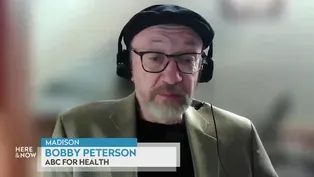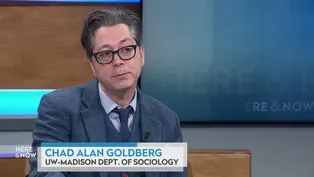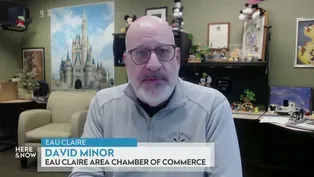Here and Now
Dale Knapp on a Projected Population Decline for Wisconsin
Clip: Season 2300 Episode 2326 | 5m 43sVideo has Closed Captions
Dale Knapp on factors contributing to a projected population decline in Wisconsin by 2050.
Forward Analytics Director Dale Knapp discusses the factors that are contributing to a projected overall population decline in Wisconsin expected by 2050 and differences in impacts around the state.
Problems with Closed Captions? Closed Captioning Feedback
Problems with Closed Captions? Closed Captioning Feedback
Here and Now is a local public television program presented by PBS Wisconsin
Here and Now
Dale Knapp on a Projected Population Decline for Wisconsin
Clip: Season 2300 Episode 2326 | 5m 43sVideo has Closed Captions
Forward Analytics Director Dale Knapp discusses the factors that are contributing to a projected overall population decline in Wisconsin expected by 2050 and differences in impacts around the state.
Problems with Closed Captions? Closed Captioning Feedback
How to Watch Here and Now
Here and Now is available to stream on pbs.org and the free PBS App, available on iPhone, Apple TV, Android TV, Android smartphones, Amazon Fire TV, Amazon Fire Tablet, Roku, Samsung Smart TV, and Vizio.
Providing Support for PBS.org
Learn Moreabout PBS online sponsorshipgood day.
>> Wisconsin's population is on a steep decline.
The latest projection from the state Department of Administration shows Wisconsin's population is expected to decline by nearly 200,000 residents by 2050.
It's all about aging and babies and migration in and out of the state.
But what are the implications for Wisconsin in the face of a population drop off?
We turn to Dale Knapp, director of forward Analytics.
And thanks very much for being here.
>> So we just kind of named what we think is going on, but what are the drivers of population decline in Wisconsin?
>> Well, you know, the baby boomers that, that that demographic, you know is one of the drivers that they're now entering their, their later years.
But really the big the two big drivers of this population decline that we're now beginning to, to see is the lack of, of babies.
We've seen the number of births drop every year, but two since 2007.
The births in 2000, 23 were the lowest since 1942.
That's amazing.
And then the other piece is the other component is migration.
We saw big net migration into the state, into the 1990s, and it's lagged ever since.
And when you have the demographics that we do kind of baked into our future growth or no growth, you need migration into the state to fill those gaps.
And we're not seeing that.
>> Where are population declines happening fastest in the state?
They're happening fastest in the rural North.
>> You know, they've been that's been going on for 20 years.
Slow growth and then some decline.
We saw a bump in this last decade in the census in a number of counties in the north.
But it was really all baby boomers that have retired moving north, which doesn't help for workforce.
And those key things that they need to, you know, for, for their economy.
But, you know, as they age, that's going to, you know, they're going to move on as well.
So, so certainly people have been talking about this for a long time.
>> We have known it has been coming, but is it worse than expected in your mind?
>> No, I don't I think it's a little bit worse because of the decline in births.
Births generally move up and down in kind of cycles.
And when birth started to decline in 2007, I think most demographers thought, you know, that was going to be temporary.
It was going to be, you know, six, seven, eight, ten years.
And it's not been it's continued.
And it's happening.
Happening everywhere.
And unfortunately, there's really no signs that that's going to change in the near future.
And so I think that's the that's the part that has sort of surprised us over, over the past, you know, 5 or 6 years and has made the projections as you look out, look, you know, much worse.
>> So what are the implications for population drop offs of this magnitude?
>> Well, you know, there there there's a lot of implications.
I think the number one that you look at is workforce.
Our 25 to 64 year old population is expected to decline by almost 200,000.
Just in this decade.
And then more over the following couple of decades.
We're already looking at labor shortages everywhere throughout the state, so it's not only going to continue, it's likely to get worse.
And then when you look a, you know, especially the declines in births, the impact there on schools whose funding is tied to enrollment, we're likely to continue to see declining enrollment there.
And financial challenges for our schools.
>> So meanwhile, Dane County is the total outlier with big projected population gains by 2050.
What sets Dane County apart, and can it be replicated?
>> Well, I think you know, one of the.
Dane County is unique in that it has both.
It's the home of state government and it has the major university.
And I think when you look around the country, you'll see that those counties that have that are generally more prosperous and growing and so Dane County has all of that.
It kind of makes it a little bit recession proof to some degree, because you don't have the economic fluctuations of laying off people as much with with government.
And so that's that's part of it.
But it's also, you know, it's become a place that has a lot to offer in terms of recreation and activities and restaurants.
ET cetera.
And so people look at it and, you know, they see it as a, as a great place to, you know, raise their kids whether they want to be in a more urban area.
Madison, Or in one of the a little bit more outlying communities.
We will obviously be watching these numbers.
Doyle Knapp.
these numbers.
Doyle Knapp.
Bobby Peterson on Removing Medical Debt From Credit Reports
Video has Closed Captions
Bobby Peterson on the scale of medical bills and a rule to block debt on credit reports. (5m 27s)
Chad Alan Goldberg on Populist Politics and Jan. 6's Legacy
Video has Closed Captions
Chad Alan Goldberg on researching the rise of populism and the impacts of Jan. 6. (17m)
David Minor on the Chippewa Valley's Health Care Needs, Gaps
David Minor discusses efforts to expand hospital and clinic facilities after closures. (6m 51s)
Here & Now opening for January 10, 2025
Video has Closed Captions
The introduction to the January 10, 2025 episode of Here & Now. (1m 7s)
Providing Support for PBS.org
Learn Moreabout PBS online sponsorshipHere and Now is a local public television program presented by PBS Wisconsin















